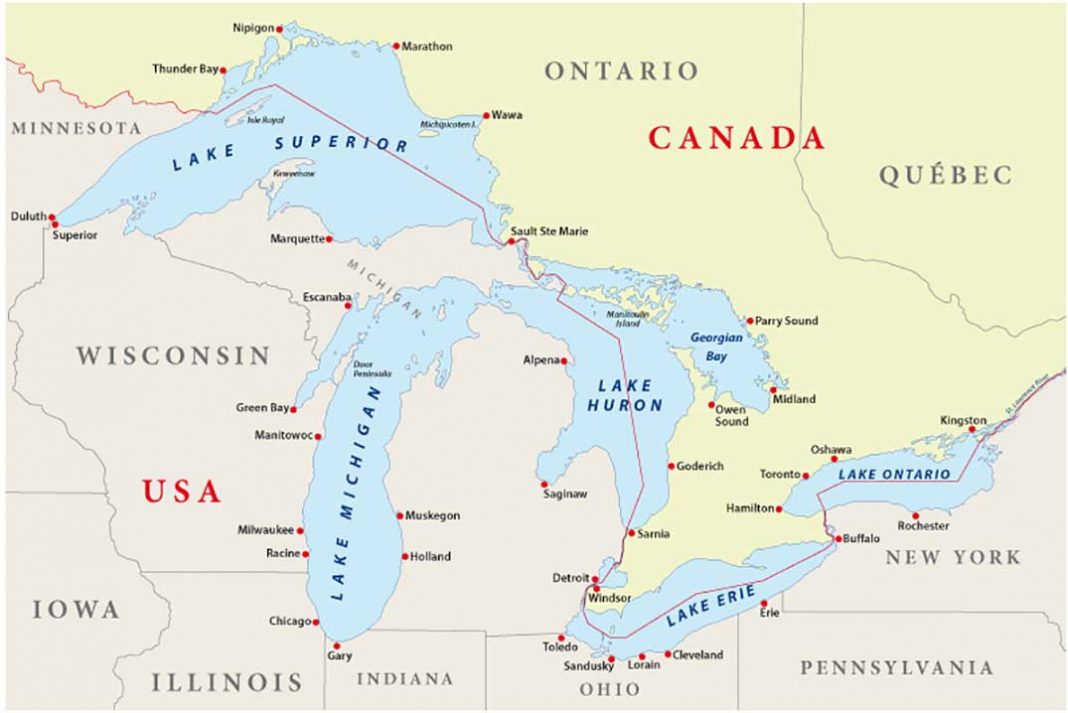EDITOR’S NOTE: The 2022 Great Lakes Public Forum, held September 27 to 29 in Niagara Falls, Ontario, was both a celebration of 50 years of successes in water quality improvements and overall ecosystem health and an opportunity to discuss concerns and emerging threats to the Great Lakes basin. Panelists shared their thoughts on the past, present and future of various aspects of the lakes including habitat health, invasive species, algal blooms, harmful chemicals, Indigenous stewardship, community initiatives and climate change. Over the next few weeks,The Expositor will look at these issues individually and consider what the next 50 years will look like.
NIAGARA FALLS—For three days last week, researchers, eNGOs, conservation authorities, government staff, Indigenous leaders, members of the public and binational organizations from across the Great Lakes basin gathered in Niagara Falls, Ontario to share successes and concerns about the state of the lakes, progress made under the 1972 Great Lakes Water Quality Agreement (GLWQA) and to discuss binational priorities for science and actions over the next three years.
The Forum is jointly held by the governments of the United States (US) and Canada every three years, to provide information and receive input.
The first study on pollution in the Great Lakes was started in 1912 and completed in 1918 by the International Joint Commission (IJC), which concluded that water quality in the Great Lakes was ‘generally chaotic, everywhere perilous and in some cases, disgraceful,’ said Mike Goffin, regional director general for Environment and Climate Change Canada (ECCC) and forum co-emcee.
By the 1950s and 1960s, the degradation of the Great Lakes due to excessive algae was so severe that some newspapers declared Lake Erie dead. The IJC began to study the situation in 1964, a time when there was a groundswell of environmental consciousness among the general populace.
On April 15, 1972 Prime Minister Pierre Trudeau and President Nixon signed the GLWQA. The agreement recognized the need for binational collaboration and coordination and committed the two countries to restoring water quality in the Great Lakes. The initial focus was on reducing phosphorus pollution, nuisance conditions and the discharge of toxic substances.
The agreement was revised in 1978, when the ecosystem concept was first introduced. Ecosystem was defined as ‘the interactive components of the air, land, water, and living organisms including man, within the drainage basin.’
Another revision was made in 1987 when commitments were made to restore Areas of Concern and required the development of Lakewide Area Management Plans for each of the lakes. In 2012 the GLWQA was revised once again, strengthening accountability and reporting.
Things have changed considerably over the past 50 years but there is still a lot of work to do, said Chris Korleski, director of the Great Lakes National Program Office.
The agenda format was a change over previous forums, with a series of panel discussions focusing on “what happened, what’s happening and what’s going to happen.” Panels consisted of people from various agencies, government, Tribes, First Nations, eNGOs, academics and others all offering a perspective from “their own particular situations, in their own particular ways, to the restoration and protection of the Great Lakes,” Mr. Korleski said.
Perhaps Ontario Lieutenant-Governor Elizabeth Dowdeswell best summed up the thoughts and concerns of attendees in her opening address. At least from an Ontario perspective, the Great Lakes define us, she said. “We simply cannot understand Ontario without the Great Lakes.”
“Those inland seas have inspired us, whether it’s seeing through the eyes of the Anishnaabe, as the lifeblood of Mother Earth, or through the eyes of industrialists as the river highway of North America, or through the eyes of some people as a water playground for swimmers, boaters and anglers, and dare I suggest in a post-COVID world, some of us see it as a place to heal,” the Hon. Ms. Dowdeswell said.
“Our relationship with the lakes actually continues to evolve. The Great Lakes by their size and history speak to the essential need for us to connect with something bigger than ourselves, encourage a deep and emotional spiritual commitment in people.”
The Hon. Ms. Dowdeswell enjoyed a long career in the environmental sector, including working on water issues at the regional, national and international levels prior to becoming Lieutenant-Governor in 2014. The observations and lessons learned shared by the Lieutenant Governor were echoed throughout the proceedings over the next three days.
The first lesson is that collaboration, where all orders of government come together for a common cause, is necessary. This was repeated in the arenas of academia and eNGOs, who noted they couldn’t do the work they are doing without collaboration within and between sectors.
“Collaboration is the very essence of the Boundary Waters Treaty, the International Joint Commission and the work we do proactively under the Great Lakes Water Quality Agreement,” the Hon. Ms. Dowdeswell said. She recalled when the late Queen Elizabeth II opened the St. Lawrence Seaway in 1959, calling it “a great joint enterprise between our two countries and a magnificent model of the enduring friendship between our two nations.”
The term ‘ecosystem’ itself implies the interdependence of human beings and nature, “a genuine collaboration,” said the Lieutenant Governor.
Using science as the foundation of decision-making in the basin, community building, civil engagement and making space for the ecological knowledge of Indigenous peoples were also consistent factors in progressing towards healthy and sustainable lakes and watersheds.
There is still much to improve. “We need to try much harder for systemic and holistic thinking,” the Hon. Ms. Dowdeswell said. While it’s understood that sustainability is an appropriate framework in which to build resilience, the complexities within that don’t work very well in siloes.
The global pandemic has laid bare the inequities in society and the somewhat artificial siloes of the economic and social sectors have to be broken down because if we are ever to return to the economic prosperity that we’re looking for, we have to do so by dealing with social issues, she said.
This was perhaps more evident in First Nations communities. In one panel discussion on reducing risks from harmful chemicals, Sylvia Plain of the Aamjiwnaang First Nation spoke very passionately about the environmental racism her community has experienced with chemicals being dumped by reserves. “This isn’t cradle to grave but womb to grave,” she said. “Chemicals are killing us. We’re dying.”
“Decisions are being made by decision makers who live far away,” she said. “More girls are being born than boys in my community. That doesn’t make them care. What will?”
Abraham Francis of the Mohawk Council of Awkwesane said Indigenous people want to be a part of decision making but aren’t offered full participation. For example, when a panel came to do an assessment of the fish community there, they didn’t ask the community’s knowledge holders about fish species in that area, and which ones were experiencing issues.
“We need to ask ourselves how can we imagine and implement co-creation of partnerships,” said the Hon. Ms. Dowdeswell. “How do we actually do transitions, particularly in energy field. How do we scale initiatives for impact? Will we ever see the recognition for a healthy climate and environment as a human right and a recognition that perhaps the greatest power that we have to enforce that right might well lie within our own communities and neighbourhoods? Do we really believe that citizens have actual agency right here on the Great Lakes? We need to continue to agree to work on engagement, not just consultation, to have the humility and courage to make sure that the right people are in the room and that we’re all really listening.”
She commended everyone for their work of the past 50 years and for their continuing commitment to tackling coming challenges. “This forum provides a tremendous opportunity for strategy, for efficacy, and most importantly, for genuine dialogue at an urgent, urgent time.”





